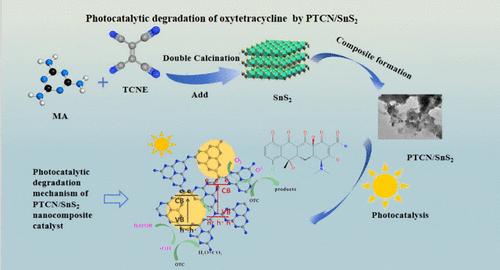四氰乙烯共石墨相氮化碳PTCN/SnS2的合成及土霉素的降解分析
IF 3.9
3区 工程技术
Q2 ENGINEERING, CHEMICAL
引用次数: 0
摘要
本研究利用四氰乙烯(TCNE)与g-C3N4共聚,通过溶剂热合成法制备了PTCN/SnS2异质结复合材料。表征表明,二次煅烧引入的质子化氮化碳(PCN)修饰了g-C3N4的结构(TEM),同时保留了其类似石墨烯的层内/层间框架(XRD/FTIR)。光致发光分析表明,tcne -共聚材料的载流子重组受到抑制,表现为发射强度降低,载流子寿命延长,从而提高了光催化活性。优化后的复合材料在可见光下对四环素和土霉素的降解率分别为81.10%和90.43%,其中PTCN/SnS2-10对金四环素的降解率为64.01%。增强的载流子迁移和分离机制使其性能优于纯相SnS2和g-C3N4。本研究通过形态学和电子调制展示了一种合理的界面工程策略,为设计高效的异质结光催化剂来对抗有机污染物提供了一种可推广的方法。本文章由计算机程序翻译,如有差异,请以英文原文为准。

Synthesis of Tetracyanoethylene Co-Graphite Phase Carbon Nitride PTCN/SnS2 and Degradation Analysis of Oxytetracycline
This study fabricated PTCN/SnS2 heterojunction composites via solvothermal synthesis, utilizing tetracyanoethylene (TCNE) copolymerization with g-C3N4 for morphology control. Characterization revealed that secondary calcination-introduced protonated carbon nitride (PCN) modified g-C3N4’s structure (TEM) while retaining its graphene-like intra/interlayer framework (XRD/FTIR). Photoluminescence analysis indicated suppressed carrier recombination in TCNE-copolymerized materials, evidenced by reduced emission intensity and prolonged carrier lifetime, thereby enhancing the photocatalytic activity. The optimized composites achieved 81.10% tetracycline and 90.43% oxytetracycline degradation under visible light, with PTCN/SnS2-10 exhibiting 64.01% efficiency for chlortetracycline. Enhanced carrier migration and separation mechanisms enabled superior performance over that of pure-phase SnS2 and g-C3N4. This work demonstrates a rational interface engineering strategy through morphological and electronic modulation, offering a generalizable approach for designing efficient heterojunction photocatalysts to combat organic pollutants.
求助全文
通过发布文献求助,成功后即可免费获取论文全文。
去求助
来源期刊

Industrial & Engineering Chemistry Research
工程技术-工程:化工
CiteScore
7.40
自引率
7.10%
发文量
1467
审稿时长
2.8 months
期刊介绍:
ndustrial & Engineering Chemistry, with variations in title and format, has been published since 1909 by the American Chemical Society. Industrial & Engineering Chemistry Research is a weekly publication that reports industrial and academic research in the broad fields of applied chemistry and chemical engineering with special focus on fundamentals, processes, and products.
 求助内容:
求助内容: 应助结果提醒方式:
应助结果提醒方式:


